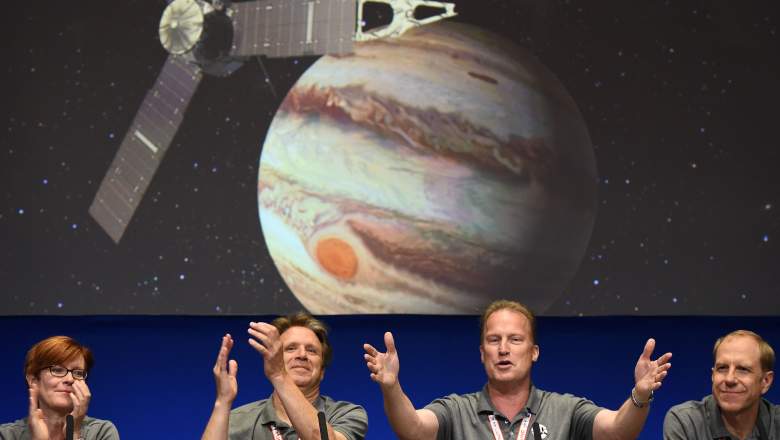
Getty NASA experts celebrate at a press conference after the Juno spacecraft was successfully placed into Jupiter's orbit. With Juno passing Jupiter's Red Spot today, how long will we have to wait to see photos?
NASA’s Juno spacecraft is flying by Jupiter’s Great Red Spot today and coming within 2,200 miles of Jupiter’s surface. This is the first close up we’ve ever seen of the 10,000 mile-wide spot on Jupiter’s surface, believed to be a monumental storm centuries old. Juno will be taking photos of the Great Red Spot as it flies over, but those photos won’t be available immediately. When will they be available and where can you go to see them?
Although Juno is passing over the Great Red Spot at around 6:55 p.m. Pacific (9:55 p.m. Eastern), the photos won’t be available for the public to see right away. NASA is estimating that the pictures will be available by Friday, July 14, and one NASA expert (see below) said it might even be at least a day before that on July 13 or possibly sooner.
Candy Hansen from NASA’s Planetary Science Institute shared more details about this on the Unmanned Spaceflight discussion forum. She said it’s not known exactly when the images will be downlinked, but it will happen as fast as possible because of the huge amount of interest. She said the most conservative estimate for photos was July 14, but they could actually arrive one day before that.
The reason for the delay is that during the flyby, Juno won’t be facing in a direction to communicate with Earth. It may even be a few hours before NASA even gets confirmation that the spacecraft is still functioning right and intact. After that, the data must be downloaded and then the photos are sent in the order in which they were taken.
Scott Bolton, of the Southwest Research Institute in Texas, told ABC Science that the first up-close views might not even arrive until at least this weekend. (The pictures taken from farther away will start arriving first.)
Here’s what Hansen said on the Unmanned Spaceflight discussion forum about the transmission of images from Juno:
When will the GRS images be downlinked? These are the factors:
* We have no downlink during the perijove pass because the spacecraft is in the MWR attitude. This means that all data must be stored on-board. The JunoCam onboard storage is 1181 Mb.
* Once downlink starts we play back engineering first, then FGM, then the other instruments
* The instrument round-robin will start at 6:40 am on Tuesday; JunoCam gets roughly 6 min per hour
* We start by playing back the images collected at -24 hr. Those images are compressed, so it is difficult to calculate the speed of playback precisely. Also, if other instruments’ buffers empty early then playback of JunoCam data will speed up.
* If the GRS images happen to be played back in the middle of the night there is no one at MSSS to see that they’ve arrived – that will happen at open of business
* Once we get the actual images we still need the c kernel with the spacecraft attitude to run the processing pipeline. Usually the C kernel arrives within a day of perijove, so this shouldn’t be a delay.
* As soon as the raw images are posted we will let everyone know that they are available at missionjuno.Very conservatively I’ve estimated July 14, expecting that it is likely we’ll see them at least a day before.
Of course, the next question is which webpage you should be constantly refreshing to see the photos.
As soon as they arrive, the Great Red Spot’s unprocessed photos will be posted on this link. NASA actually relies on the amateur image-processing community to help process the raw data into the photos you’re likely waiting to see.
The Great Red Spot is larger in diameter than the Earth. It’s been studied since the 1800s, but even in the 1600s there were reports of people seeing a large spot on the surface of Jupiter. No one is completely sure how the storm has managed to stay intact all this time.
